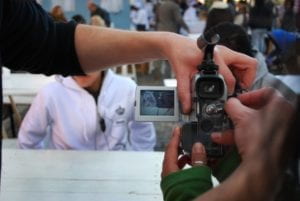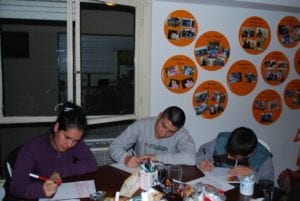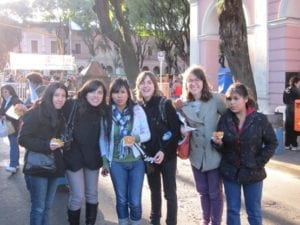Arielle Milkman
Buenos Aires, Argentina
Voluntarios Sin Fronteras
During my time in Buenos Aires, I’ve had the opportunity to get to know and participate in several exciting projects that aim to reinvent media as a tool of social inclusion. I want to do them all justice in detailed posts, so in this first formal blog entry I will simply briefly introduce one of the projects, Impulso Voluntario, a community magazine sponsored by Voluntarios Sin Fronteras. In later entries I will problematize each experience further, and recount my fieldwork in greater depth.
I am working with my host organization, Voluntarios sin Fronteras, in two major capacities. The first is the supervision of the VSF’s community magazine, Impulso Voluntariado. We currently have eight adolescents participating in the project, in which the participants photograph and document social projects in the city of Buenos Aires, as well as the activities of VSF. The members of this year’s magazine staff range from 15 to 24 years old, and travel from Villa Lujano, Villa Soldati, and Villa Retiro to participate in the project. Each of these neighborhoods has its own very specific social context, but generally speaking, they are some of the most precarious zones of Buenos Aires.
 As the courses in design, narrative journalism and photography we offer as part of the magazine’s curriculum are held in VSF’s office in the center of Buenos Aires, most of the students have to travel for at two hours to attend class. Additionally, the courses are generally held on Tuesdays and Thursdays from 6:30-8 p.m., which means that the students must return to their houses, often alone, after dark. During the first week of the program, Cintia, who had just recently moved to Buenos Aires from the province of Misiones, was robbed near her house as she tried to return from the center around 9 p.m. After the incident, Cintia’s mother said she couldn’t participate in the project, as coming back late at night could be dangerous.
As the courses in design, narrative journalism and photography we offer as part of the magazine’s curriculum are held in VSF’s office in the center of Buenos Aires, most of the students have to travel for at two hours to attend class. Additionally, the courses are generally held on Tuesdays and Thursdays from 6:30-8 p.m., which means that the students must return to their houses, often alone, after dark. During the first week of the program, Cintia, who had just recently moved to Buenos Aires from the province of Misiones, was robbed near her house as she tried to return from the center around 9 p.m. After the incident, Cintia’s mother said she couldn’t participate in the project, as coming back late at night could be dangerous.
In order to keep Cintia in the magazine, we created an earlier course so that she would be able to return home during the day, instead of at night.
Cintia and her peers earn a scholarship of 200 pesos a month (roughly 50 U.S. dollars) in exchange for their participation in Impulso Voluntario. Nonetheless, some of the students are consistently tardy or absent in classes, which slows down the progress of the magazine.
In order to organize the narrative journalism class, I proposed the creation of a blog for the group, which now serves as a documentation of the project and a place for the students to store their texts while they work on improving them for the final edition of the magazine.
 Most of the students weren’t originally familiar with blogs, and explaining the process was a bit of a challenge. Most of the magazine’s participants don’t have access to internet in their houses, and some have limited computer skills. The students in the narrative journalism class proposed the title Periodistas Voluntarios (Volunteer Journalists) for the blog, which can now be accessed at http://periodistasvoluntarios2011.blogspot.com/.
Most of the students weren’t originally familiar with blogs, and explaining the process was a bit of a challenge. Most of the magazine’s participants don’t have access to internet in their houses, and some have limited computer skills. The students in the narrative journalism class proposed the title Periodistas Voluntarios (Volunteer Journalists) for the blog, which can now be accessed at http://periodistasvoluntarios2011.blogspot.com/.
The spirit behind this project is absolutely positive, but as I have been working with the kids and the team of volunteers involved in the magazine, I can’t help but think of ways I would change the project to improve it. Preserving VSF’s basic model of a community magazine produced by adolescents from precarious neighborhoods, I would restructure the magazine by producing its contents in one specific neighborhood. I would work with adolescents from one neighborhood, instead of three, and I would set up classes to be taught in the neighborhood, instead of in a neutral environment a two-hour bus ride away. Community media works when it is localized and focused on a specific beat, for a specific public. The problem with Impulso Voluntario, VSF’s magazine, is that the adolescents who write and design each issue are placed into unknown contexts, which are often uninteresting to them. They are often asked to cover events hosted by VSF, which have little direct impact on their communities. From my perspective, a community magazine based in the neighborhoods the participants live and work in would be much more effective as a legitimate project of social inclusion and cultural expression.